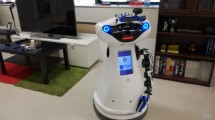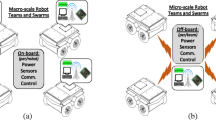Abstract
Robots have been a subject of research for almost half a century. In order to make robots more versatile they must be able to operate in a semi-structured work place where unforeseen events occur and where sensor data are incomplete. An entire research community has been working on this problem and many unique autonomous and so-called intelligent robots have been conceived and built. Most of these efforts are concerned with robots that operate in the macroworld where they take on chores that could also be handled by humans. However, there is the mocroworld in which manipulation and handling tasks are very difficult and for which a human has no tools and where the work area is so small that fine manual manipulation is almost impossible. This paper is concerned with autonomous robots that can operate in a microworld, where microassembly operations, microsurgery or integrated circuit testing and repair is done. For independent operations, these robots need special sensors and an efficient computer architecture that hosts the planner and executor. There are also special drive systems and effectors necessary for micromotions and micromanipulations, respectively. An attempt is made to describe these components and the problems encountered in configuring them to a microrobot. As an example of advanced microrobots, the design and functions of several autonomous microrobots of the University of Karlsruhe are shown; they employ different locomotion and subject handling principles. The paper also includes a discussion of the typical operating problems caused by the microworld and of future research that has to be done to conceive and build efficient microrobots.
Similar content being viewed by others
References
Gengenbach, U. et al.: Ein System zur automatischen Montage von Mikrosystemen, in: Tagungsband des 2. Statuskolloquiums des Projektes Mikrosystemtechnik, Forschungszentrum Karlsruhe, 1995, pp. 62–66.
Frick, O.: Fertigungsgerechte Montage-und Fügeverfahren für Mikrosysteme, in: Tagungsband des 2. Int. Kongresses für Mikrosysteme und Präzisionstechnik, 1995, pp. 44–51.
Fatikow, S. and Rembold, U.: An automated microrobot-based desktop station for micro assembly and handling of microobjects, in: Proceedings of the IEEE Conference on Emerging Technologies and Factory Automation, 1996, pp. 586–592.
Fatikow, S. and Munassypov, R.: An intelligent micromanipulation cell for industrial and biomedical applications based on a piezoelectric microrobot, in: Proceedings of the 5th Int. Conference on Micro Electro, Opto, Mechanical Systems and Components, 1996, pp. 826–828.
Magnussen, B., Fatikow, S., and Rembold, U.: Actuation in microsystems: Problem field overview and practical example of the piezoelectric robot for handling of microobjects, in: Proceedings of the INRIA/IEEE Conference on Emerging Technologies and Factory Automation, Vol. 3, 1995, pp. 21–27.
Fatikow, S., Magnussen, B., and Rembold, U.: A piezoelectric mobile robot for handling of microobjects, in: Proceedings of the Int. Symposium on Microsystems, Intelligent Materials and Robots, 1995, pp. 189–192.
Munassypov, R., Grossman, B., Magnussen, B., and Fatikow, S.: Development and control of piezoelectric actuators for the mobile micromanipulation system, in: Proceedings of the Int. Conference on New Actuators, 1996, pp. 213–216.
Author information
Authors and Affiliations
Rights and permissions
About this article
Cite this article
Rembold, U., Fatikow, S. Autonomous Microrobots. Journal of Intelligent and Robotic Systems 19, 375–391 (1997). https://doi.org/10.1023/A:1007987316940
Issue Date:
DOI: https://doi.org/10.1023/A:1007987316940




